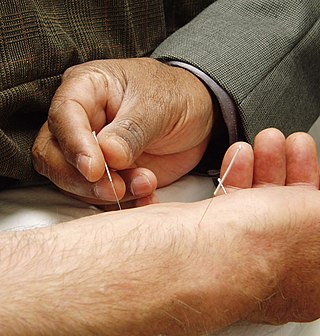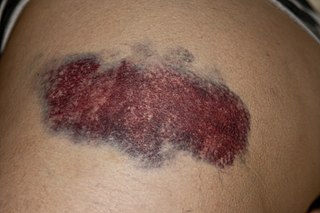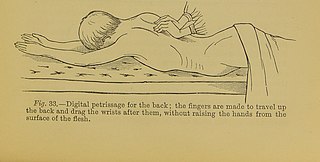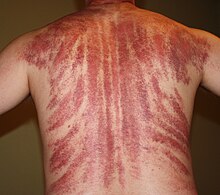
Acupuncture is a form of alternative medicine and a component of traditional Chinese medicine (TCM) in which thin needles are inserted into the body. Acupuncture is a pseudoscience; the theories and practices of TCM are not based on scientific knowledge, and it has been characterized as quackery.

Traditional Chinese medicine (TCM) is an alternative medical practice drawn from traditional medicine in China. It has been described as pseudoscientific, with the majority of its treatments having no known mechanism of action.

Massage is the rubbing or kneading of the body's soft tissues. Massage techniques are commonly applied with hands, fingers, elbows, knees, forearms, feet or a device. The purpose of massage is generally for the treatment of body stress or pain. In European countries, a person professionally trained to give massages is traditionally known as a masseur (male) or masseuse (female). In the United States, these individuals are often referred to as "massage therapists". In some provinces of Canada, they are called "registered massage therapists."

Bloodletting is the withdrawal of blood from a patient to prevent or cure illness and disease. Bloodletting, whether by a physician or by leeches, was based on an ancient system of medicine in which blood and other bodily fluids were regarded as "humours" that had to remain in proper balance to maintain health. It is claimed to have been the most common medical practice performed by surgeons from antiquity until the late 19th century, a span of over 2,000 years. In Europe, the practice continued to be relatively common until the end of the 19th century. The practice has now been abandoned by modern-style medicine for all except a few very specific medical conditions. In the overwhelming majority of cases, the historical use of bloodletting was harmful to patients.

Moxibustion is a traditional Chinese medicine therapy which consists of burning dried mugwort on particular points on the body. It plays an important role in the traditional medical systems of China, Japan, Korea, Vietnam, and Mongolia. Suppliers usually age the mugwort and grind it up to a fluff; practitioners burn the fluff or process it further into a cigar-shaped stick. They can use it indirectly, with acupuncture needles, or burn it on the patient's skin.

Effleurage, a French word meaning 'to skim' or 'to touch lightly on', is a series of massage strokes used in Swedish massage to warm up the muscle before deep tissue work using petrissage.

A bruise, also known as a contusion, is a type of hematoma of tissue, the most common cause being capillaries damaged by trauma, causing localized bleeding that extravasates into the surrounding interstitial tissues. Most bruises occur close enough to the epidermis such that the bleeding causes a visible discoloration. The bruise then remains visible until the blood is either absorbed by tissues or cleared by immune system action. Bruises which do not blanch under pressure can involve capillaries at the level of skin, subcutaneous tissue, muscle, or bone.

Petrissage is a massage technique that applies deep pressure to the underlying muscles. Kneading, wringing, skin rolling, and pick-up-and-squeeze are the petrissage movements. They are all performed with the padded palmar surface of the hand, the surface of the finger and also the thumbs.

Tui na is form of alternative medicine similar to shiatsu. As a branch of traditional Chinese medicine, it is often used in conjunction with acupuncture, moxibustion, fire cupping, Chinese herbalism, tai chi or other Chinese internal martial arts, and qigong.

Cupping therapy is a form of pseudoscience in which a local suction is created on the skin with the application of heated cups. As alternative medicine it is practiced primarily in Asia but also in Eastern Europe, the Middle East, and Latin America. Cupping has been characterized as a pseudoscience and its practice as quackery.

A petechia is a small red or purple spot that can appear on the skin, conjunctiva, retina, and mucous membranes which is caused by haemorrhage of capillaries. The word is derived from Italian petecchia, 'freckle,' of obscure origin. It refers to one of the three descriptive types of hematoma differentiated by size, the other two being ecchymosis and purpura. The term is typically used in the plural (petechiae), since a single petechia is seldom noticed or significant.
The Gua Sha Treatment is a Chinese movie directed by Zheng Xiaolong released in 2001 starring Tony Leung Ka-Fai, Zhu Xu, and Jiang Wenli. It is a story about cultural conflicts experienced by a Chinese family in the United States. Misunderstanding caused by traditional Chinese medicine threatens to separate a family - will this family overcome conflict between eastern and Western cultures?
Infection prevention and control is the discipline concerned with preventing healthcare-associated infections; a practical rather than academic sub-discipline of epidemiology. In Northern Europe, infection prevention and control is expanded from healthcare into a component in public health, known as "infection protection". It is an essential part of the infrastructure of health care. Infection control and hospital epidemiology are akin to public health practice, practiced within the confines of a particular health-care delivery system rather than directed at society as a whole.
Blood stasis (BS) is a concept in traditional Chinese medicine (TCM), described as a slowing or pooling of the blood due to a disruption of heart qi. Blood stasis is also described by practitioners of TCM in terms of yin deficiency, qi deficiency and qi stagnation. For non-practitioners of TCM it is sometimes explained in terms of hematological disorders such as hemorrhage, congestion, thrombosis or local ischemia, and in terms of tissue changes. TCM practitioners believe it is an important underlying pathology of many disease processes despite the fact that objective, consistent methods for measuring the presence of blood stasis syndrome are not readily available. Blood stasis is associated with justifications for acupuncture and herbal treatments.
Traditional Thai medicine is a system of methods and practices, such as herbal medicine, bodywork practices, and spiritual healing that is indigenous to the region currently known as Thailand. While not all Buddhist medicine is Thai, Thai medicine is considered Buddhist medicine.
Cat massage is a practice used by veterinarians and at home by pet owners to apply massage therapy techniques to domestic cats, primarily for relieving pain and discomfort, as well as a means of strengthening the cat–human bond through intimate interaction.
Vietnamese units of measurement are the largely decimal units of measurement traditionally used in Vietnam until metrication. The base unit of length is the thước or xích. Some of the traditional unit names have been repurposed for metric units, such as thước for the metre, while other traditional names remain in translations of imperial units, such as dặm Anh for the mile.
Xu Ting, known as Kitty Xu Ting, was a Chinese actress and blogger who died of cancer in 2016. Previously known for her appearances in Dad Home and Lost in Macau, she was a popular blogger on the microblogging website Sina Weibo with 300,000 followers. Her death received widespread press attention for her refusal to use modern medical treatments such as chemotherapy, in favor of Chinese traditional remedies.

The usage of cash coins in the pseudoscientific practice of traditional Chinese medicine (TCM) are primarily used in two main medical practices, notably coin rubbing and the preparation of "coin teas". Coin rubbing is practiced by ethnic Han Chinese and others in many parts of Southeast Asia and is primarily used as a treatment for "hot" diseases and is related to the more familiar pseudoscientific practices of cupping therapy and acupuncture.















